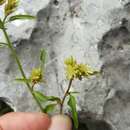Comments
provided by eFloras
In the original description, S. Watson indicated that Celosia palmeri occurs in "western Texas and northeastern Mexico." Celosia palmeri has been reported from Cameron County, Texas (C. F. Reed 1969b) and the trans-Pecos region of Texas (C. F. Reed 1970). We have been able to confirm its occurrence only in the south Texas plains region. Herbarium specimens of C. palmeri are typically paler green than those of C. nitida.
- license
- cc-by-nc-sa-3.0
- copyright
- Missouri Botanical Garden, 4344 Shaw Boulevard, St. Louis, MO, 63110 USA
Description
provided by eFloras
Shrubs, perennial, ± 0.3-1 m; rootstock stout. Stems erect or clambering, much-branched from rootstock, mostly glabrous. Leaves: petiole 0.5-2 cm; blade somewhat hastately lobed, lanceolate to ovate-lanceolate, 2-4.5 × 0.5-1.7 cm, base long-tapering, apex acute to acuminate or rounded-mucronate. Inflorescences compact panicles of few terminal or axillary spikes near the tips, becoming more open in fruit, units less than 10 mm diam. Flowers: tepals whitish with reddish base, striate, drying tan, darker in middle, ± equal, 4-5 mm, rather rigid, glabrous or occasionally sparsely villous; style 1 mm; stigmas 2. Utricles 4-6 mm. Seeds 3-5, 0.8-1.3 mm diam., faintly reticulate or smooth.
- license
- cc-by-nc-sa-3.0
- copyright
- Missouri Botanical Garden, 4344 Shaw Boulevard, St. Louis, MO, 63110 USA
Distribution
provided by eFloras
Tex.; Mexico (Coahuila, Nuevo León, San Luis Potosí).
- license
- cc-by-nc-sa-3.0
- copyright
- Missouri Botanical Garden, 4344 Shaw Boulevard, St. Louis, MO, 63110 USA
Habitat
provided by eFloras
Brush-covered, rocky-gravelly hills; 0-30m.
- license
- cc-by-nc-sa-3.0
- copyright
- Missouri Botanical Garden, 4344 Shaw Boulevard, St. Louis, MO, 63110 USA
Comprehensive Description
provided by North American Flora
Celosia palmeri S. Wats. Proc. Am. Acad. 18: 143. 1883
Low shrub, much branched; branches slender, glabrous up to the inflorescence, or sparsely puberulent; petioles slender, 3-12 mm. long; leaf-blades lanceolate to lancetriangular in outline, 1.5-5 cm. long, 4—25 mm. wide, more or less asymmetric, hastately lobed, the lobes shallow and rounded, acute or obtuse at the apex, obtuse to cuneate at the base, shortly decurrent, green, glabrous, or sparsely puberulent beneath; flowers few, sessile in short spikes 1-2 cm. long and 8 mm. in diameter, 2-5 spikes clustered at the end of each branch, the rachises of the inflorescence sparsely tomentulose; bracts ovate or ovate-oblong, half as long as the sepals or shorter, acute to acuminate, often with a pungent tip, sparsely villous; sepals 5 mm. long, oblong, acute or acutish, paleor deep-brown, thin, many-nerved; stamens 5, the filaments equaling or exceeding the ovary, dilated at the base, the intervening sinuses obtuse; style longer than the ovary; stigmas 2, shorter than the style; utricle elongate-ovoid, shorter than the sepals; seeds 3 or 4, rotund, 1 mm. in diameter, smooth, black, shining.
Type locality: Monclova, Coahuila.
Distribution: Western Texas and northeastern Mexico.
- bibliographic citation
- Paul Carpenter Standley. 1917. (CHENOPODIALES); AMARANTHACEAE. North American flora. vol 21(2). New York Botanical Garden, New York, NY
Celosia palmeri: Brief Summary
provided by wikipedia EN
Celosia palmeri, commonly known as Palmer's cockscomb, is a species of flowering plant in the amaranth family, Amaranthaceae, that is native to the lower Rio Grande Valley of Texas in the United States as well as northeastern Mexico. The specific name honours British botanist Edward Palmer (1829–1911), who collected the type specimen in Monclova Municipality, Coahuila in 1880. It is a perennial shrub reaching a height of 0.3–1 m (0.98–3.28 ft). Flowering takes place from summer to winter.
- license
- cc-by-sa-3.0
- copyright
- Wikipedia authors and editors

